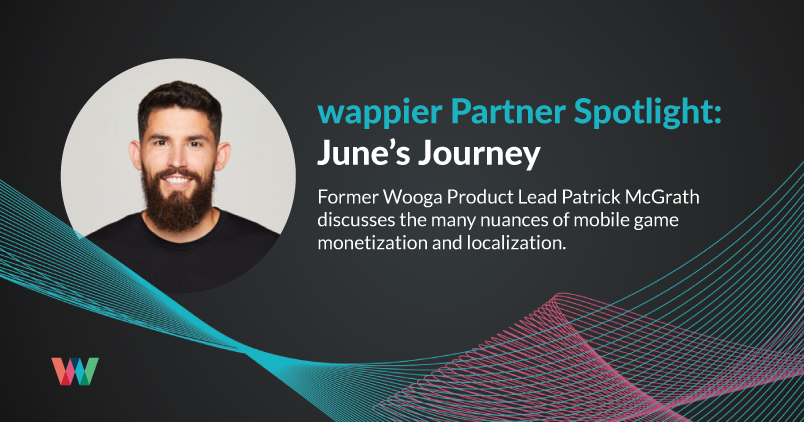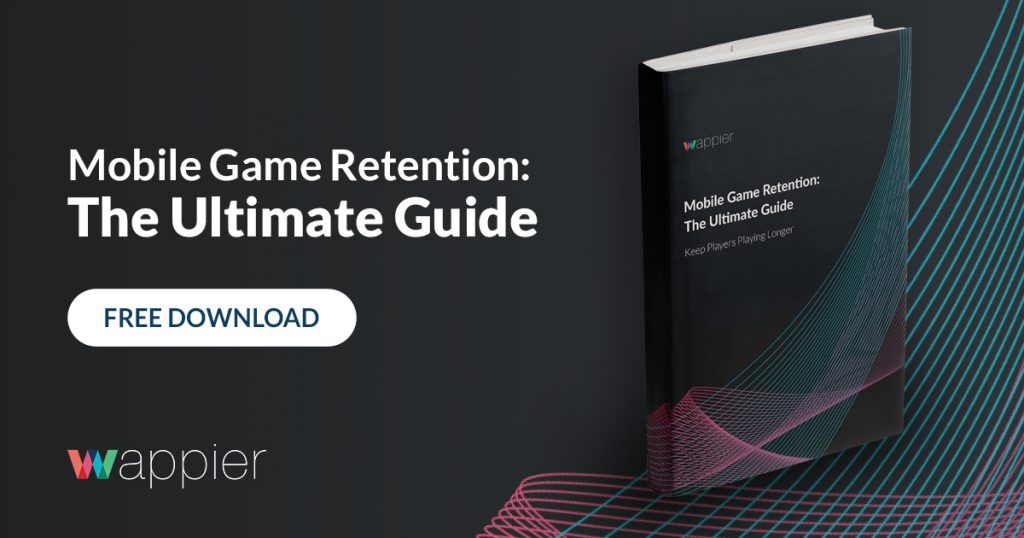Former Wooga Product Lead Patrick McGrath discusses the many nuances of mobile game monetization and localization.
When mobile game studio Wooga first opened its doors in 2009, it did so with a straightforward mission: to create joyful story-driven casual games with high production values. Since then, Wooga moved beyond its early successes on Facebook and has launched a handful of games for mobile platforms, including its very successful hidden object game June’s Journey. At a time when the hidden object genre had largely faded from the casual gaming scene, Wooga revitalized the format by mixing puzzle mechanics with engaging world-building.

In under four years, June’s Journey has racked up hundreds-of-millions of downloads on the App Store and Google Play, as well as millions of dollars in revenue. We recently sat down with Patrick McGrath, the former Product Lead of June’s Journey at Wooga, to pick his brain about the game’s path to success and what other mobile developers can learn from Wooga’s strategies.
What we learned:
- Keep content coming: Modern mobile gamers expect frequent updates and events. A soft launch can help you figure out a realistic content release schedule that keeps players happy while being realistic for developers.
- Localization is key: Mobile devs can’t just rely on the United States for revenue anymore. This goes beyond languages and into optimizing in-app purchases to ensure their value in local currency.
- Deliver value with each purchase: The worst thing for retention is buyer’s remorse, so make sure players are getting good value out of their first purchase. If they make an in-app purchase and regret it, they’re not coming back.
Hi Patrick, thanks for sitting down with us. To kick things off, can you speak to the design of June’s Journey? What’s the story behind creating both a hidden object game and a world-building game, and what led to the decision to merge those two aesthetics?
Well, before I joined the studio to work on June’s Journey, Wooga made Pearl’s Peril, which was also a hidden object game. It was fairly successful, and they realized that the hidden object genre was largely untapped in the modern free-to-play mobile format. Hidden object games were huge when internet gaming first started, but as mobile gaming overtook platforms like web and Facebook games, the genre was left behind.
When Wooga made Pearl’s Peril, the developers realized that they could do something that no one else was doing. They came up with a gameplay loop that encouraged building up an island while progressing through the story and discovered that it tied into the core loop really well. After they saw the early results of Pearl’s Peril, it was obvious that they were on to something that was sustainable. So the idea behind June’s Journey started with wanting to further optimize Pearl’s gameplay loop. And because of that experience with Pearl’s Peril, Wooga got a critical head start compared to others in the industry looking to build hidden object games.
Did you have demographics or a target audience in mind when creating June’s Journey? Is there a substantial overlap of folks who enjoy hidden object games and world-building games?
We had a pretty good idea just from the historical standpoint of what Pearl’s had done and what we had seen from previous hidden object games. We had a really, really good understanding of the demographic, and we refined the story and the beats with that demographic in mind. For example, we were the only hidden object game out there without a lose condition. You actually cannot lose in June’s Journey. This kind of gameplay was a key differentiator for our demographic, which on average is around 55-years old and predominantly female. This is something that a lot of our younger creators were testing with their parents, and we found that unlike younger gamers, our audience isn’t really interested in grind-based gameplay. Understanding what that core demographic needed was vital to our success.
How were the onboarding process and first-time user experience designed and iterated? Did you have a soft launch?
We did a very short soft launch, because we were fairly confident. Our soft launch was really about content cadence: Could we promise an amount of content releases that we could actually keep up with? How fast are players burning through this content? How much are we going to have to create on a weekly cadence? And are we prepared in six months if the soft launch doesn’t go well? Are we ready for a worldwide release?
I actually joined Wooga the month of the June’s Journey launch, so that was an interesting time. The game starts with a cut scene, and then there’s a good minute of dialogue, and by the time you’re actually playing the game, minutes have passed. When we first started running surveys in games, we found that the majority of our players didn’t identify as gamers… while answering a survey inside a game. Since then, the mobile audience has become much more comfortable with identifying as gamers, so Wooga wants to make sure they’re getting to the actual gameplay as quickly as possible. The entire market has become more savvy, especially in the West, and they just don’t have the patience for long, drawn-out onboarding loops anymore.
What classic mobile performance stats were you monitoring during the soft launch? First time conversion targets? Retention targets? Did you make any modifications to better hit those targets?
For June’s Journey, retention was certainly looked at and scrutinized. However, one of the fundamentals of the hidden object genre is that they’re long-tail games. The Day 1 or Day 7 might not be as high as other mobile games, so we look at Day 14, Day 30, Day 365, and Day 720. We tried to use early data as a proxy to tell us how sustainable the game would be.
We have the same approach with revenue KPIs, like ARPDAU, and the soft launch gave us an indicator of what long-term results might look like. At the time, I think the expectations were fairly low as far as what June’s Journey ARPDAU could be, as well as what hidden object games could achieve as well. So in that soft launch, we were really scrutinizing retention and engagement metrics, just making sure that the session lengths and daily data cycles were healthy.
A few months ago, Wooga celebrated June’s third anniversary, and there was a fairly large cohort of early players that experienced that anniversary with us. When you look at metrics for 30 to 60 days, you get a good understanding of how many players are going to stick around for the long term, and that worked for us!
How does monetization factor into that? Were you seeing a lot of first session conversions, or was it the longer term, deeply engaged players driving IAP revenue?
One of the more interesting analyses we ever saw was the amount of people purchasing before they even finished the tutorials. There was a point in a tutorial where players could click outside of the on-rails experience and find the in-app purchase store, and there was a good portion of players making purchases at this point. So even without an understanding of the value of in-game currencies and items, they were buying first thing. It’s a good problem to have, but it was a head-scratcher.
For the level of revenue that June’s has risen to, it’s more of the sustainable repeat conversions that are driving IAP revenue. I think the SKUs and the store we released were fairly conservative. I would almost liken it to many of these RPG pricing strategies, only without the constant flow of rewards. The reason for that is that the reward space in June’s Journey is fairly tight, so a lot of the in-app purchases have very high in-game economic value.
Did you find that there was a good correlation between retained players and higher-priced bundle conversions? What sort of design helped facilitate that balance?
A big thing was price anchoring. We wanted players to be able to say, “Okay, that’s a great deal compared to this, compared to that.” We really wanted the price anchoring to be fairly obvious so that making certain purchases was almost a no-brainer.
At the same time, we were looking at first-time conversions. For many players, their second session was the right time to make a purchase, so the game introduced the first-time purchase bundle. That’s what it’s there for, right? And this was one of those introductory things that many of the players were eager to take advantage of.
Did you find that there was a good correlation between retained players and those first-time bundle conversions?
It’s hard to test this, but one of the things that we saw was that first-time bundle purchasers who bought things on sale were actually worse long-term purchasers. If your first purchase is 80% off, you’re going to wait around until the next sale to buy something else. And if there is no sale, they’ll get frustrated and leave. We did a lot of tests around first-time conversions, but it’s fairly hard to have a proper A/B test on something like this and get conclusive evidence that one thing is better than the other.
Were there any other factors that you found correlated to high player value? Those who connected socially using the Facebook integration, for example?
This is something that we did look into. We really didn’t see a higher correlation, one way or the other. One of the things that we’ve noticed is that as the market became more mature, players are getting more comfortable with microtransactions. Western markets in particular have slowly started to get more comfortable with this kind of value proposition. Years ago, if you spent five bucks in a free-to-play game, people would say “Are you crazy?” But now, it’s only five bucks. People pay $15 to see a movie, and that’s only two hours of entertainment.
I think as people have gotten more comfortable with this, stats like Facebook-connected users being more valuable slowly went away. This is something that I had seen and Wooga had seen in the past. And so we kept an eye on it.
Folks all over the industry are seeing a diverse reaction to COVID-19 and lockdowns. Some genres are performing better, some are going down. Some are seeing organic acquisition increase, while some are benefitting from paid acquisition. What’s been the impact on June’s Journey? Are you seeing higher engagement or user acquisition with so many people staying at home?
I think the market as a whole benefitted overall those first couple months. From an acquisition standpoint, there were some very quick actors, and those that acted quickly really, really benefited massively. Those first couple of months changed everything, they actually changed the trajectory of some companies. I know a number of games that went from tens of thousands of users a day to hundreds of thousands, simply from ramping up UA; the growth was astronomical.
Now, of course, because you’re doing so much paid acquisition, you can expect retention to drop. If you were looking at per-player metrics from a monetization standpoint, they were high at the very beginning and then slowly started to drop as your core audience settled in, and hopefully you’ve grown larger than your initial playerbase. But there were times when we wondered, “Is this dangerous? Did we hit our peaks? Are we dropping too much, is this sustainable? Are we going to plateau and how can we predict when that will happen?”
One thing I initially had to worry about was the economic effect, because COVID-19 had some very dramatic results as far as job loss around the world. The value of mobile is its wide reach; you can hit everybody. But what if everybody can’t pay for entertainment because they’re struggling to make ends meet? Would we see that precipitous drop in revenue? So far, June’s Journey hasn’t quite seen that, but I think as we start to look at these annual reports that are now coming out, we’ll get a better idea of what happened in 2020.
What was your specific approach to global pricing and reaching a global audience with June’s Journey? Is your user base primarily in the Americas and the UK, or do you have a global audience? And what considerations, if any, did you have to take in mind when moving into those new markets?
One of the growth strategies we had for June’s Journey was expanding to a global audience. The days of relying on just the United States are long gone, and being a top game in the US isn’t enough anymore. One of the basic functions within a game team or company is localization, because it’s 2021, and people want to be able to play games in their native language. But it’s not just a matter of simple translation; there are nuances that can really make a difference. Just look at Spanish — Mexican Spanish is different from Spanish in Spain. When you start to grow globally you have to keep this stuff in mind. You can’t just rely on English speakers anymore.
The other important factor when expanding to a global audience is how your in-game currency measures up to the local economies, which is why we teamed up with wappier in the first place. Just look at Brazil — an in-app purchase that cost the equivalent of $1 a few years ago now costs the equivalent of $6, and that value proposition isn’t good. Realistically, you’re not going to sell anything that way. You need to be able to localize your games for at least the biggest markets around the world.
And no matter what, you don’t want buyer’s remorse. That’s the worst thing that could happen, and you will lose players — there is no patience for that, because you just took their money and didn’t deliver. At a minimum, they just need to feel that their purchase was a good use of money and time.
I think one of the things we’ll see more of in the future is live events being more localized, not just pricing. For example, I have quite a few friends that live in India, and there are always celebrations happening there. Even just having an event for Lunar New Year is a must nowadays, especially to your Chinese market, but that’s just the start. Every country has its own celebrations; Mother’s Day and Father’s Day are different everywhere, and it’s something developers really need to think about in the localization process.
Do you consistently see that those live events initiatives are worth the time spent on them?
It’s something that Wooga is still trying to grow into, but it’s a little awkward when 40% of your user base doesn’t have Mother’s Day, and you’re running a Mother’s Day event and sale. I think we’ll continue to see this trend grow so players in different regions can celebrate their own local cultural events and feel included. The tricky part is making sure that players globally feel like they’re getting the same benefits, even if they don’t have the same events.
Thanks again to Patrick McGrath for chatting with us about June’s Journey and the state of the mobile game industry!








